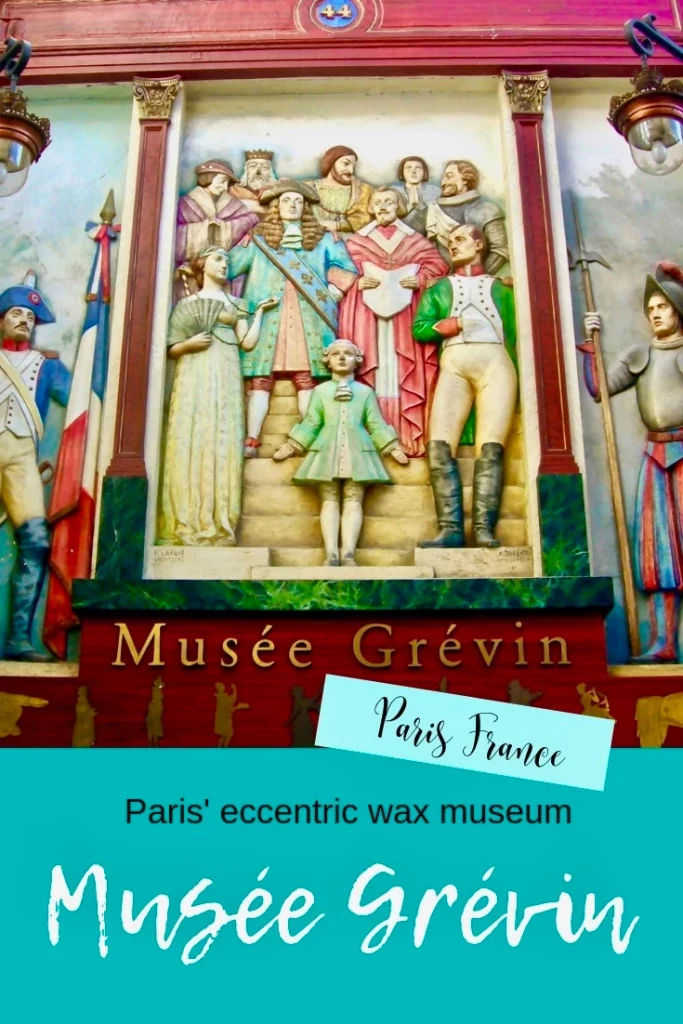About five years ago, I took my youngest daughter off to California to visit her older sister in college. Gillian wasn’t much interested in college, or even her sister really. She just wanted to head to Los Angeles and soak up the celebrity aura. Her top choices? Universal Studios and Madame Tussauds.
I grudgingly went along. It’s not really my style. But what’s a mother to do?
I remember her reaction to Madame Tussauds. She was entranced. And so on one of my Parisian geographical cures, I took myself off to the Belle Epoque Musée Grévin. If you want to rub shoulders with celebrities and go to a quirky small museum in Paris, that’s the place to go.
It’s even expanded to Montreal.
Inaugurated in 1882, and located in the historic Passage Jouffroy, the Grévin Museum is a veritable Parisian tourist institution. It’s not a museum that many tourists frequent. It’s not one that I would typically put on my itinerary because it could be considered cheesy. As you no doubt guessed, it’s a wax museum. Sacré bleu!
But three things drew me there, despite my aversion to all things kitschy. First, I did it to bond with Gillian, to be able to regale her with lurid tales of waxy celebrities. And also because the museum had a gorgeous architectural setting and a creepy wax depiction of radical French Revolutionary Jean-Paul Marat.
I adore the French Revolution. I adore Paris’ gloomy La Conciergerie.
The museum was the brainchild of prominent La Galoise newspaperman Arthur Meyer. In the pre-photography era, he dreamt of showing his loyal readers real life versions of the people they had read about.
Using Madame Tussauds in London as a model, he enlisted the help of Alfred Grévin, a caricaturist, sculptor, and designer of theatre costumes. Grévin created the first wax figures and did such a fantastic job that the museum bears his name.
Meyer also chose a fantastic venue for his eccentric collection, a Belle Epoque wonder with beautiful Baroque architecture.
The Grevin Museum was an instant success. As befits a popular attraction, it expanded rapidly. Now, there are nearly 800,000 visitors per year.
In 1900, to coincide with the Paris World’s Fair, a Hall of Mirrors was added, based on the real one in Versailles. It used scientific principles to play games with light and perspective. It had a major makeover in 2018 by artist Krysle Lip.
A theater was also added, designed by architect Gustave Rives, which is now a National Monument.
In the museum’s themed rooms, visitors can relive French and world history. There are over 500 replicas of famous entertainers, politicians, historical figures, and painters. Luminaries include Albert Einstein, Louis XIV, Gandhi, Alfred Hitchcock, Marie Antoinette, Michael Jackson, Mick Jager, Auguste Rodin, Victor Hugo, and Leonardo da Vinci.
Producing a Grevin sculpture takes six months and costs 50,000 -60,000 euros.
It’s cleverly presented. And the exhibits change frequently. There are plenty of opportunities for selfies with your favorite celebrities. (I am super terrible at selfies, so I usually just don’t bother. ) You can pose right along side them.
I present some of my personal favorites.
All this gives the Grevin Museum a unique balance of magic and horror. If you are at all childlike or prone to flights of fancy (judging from Netflix, most people are), it’s irresistible.
The exhibit I was most interested in was the depiction of Jean-Paul Marat’s death in the bathtub. If you’re a fan of French Revolutionary history (perhaps not quite as popular as Netflix), you’ll know that Marat was a radical and outspoken journalist and politician. He was an extreme leftist.
Marat advocated on behalf of the poorest members of society. But his antidote to their mistreatment, during Robespierre’s Reign of Terror, was to kill all the aristocrats, preferably via guillotine with a simulacrum of a trial.
Marat also had a peculiar skin condition that caused him to take to his bathtub regularly. There are many references to his skin condition, but nothing saying exactly what it was, to my frustration. Marat would even work in the tub, scribbling away at his diatribes. I guess it’s not a bad way to work, especially if you throw in some epsom salts.
Marat’s murder was later famously portrayed by fellow Jacobin nd Salon painter Jacques-Louis David. It’s an idealized painting (showing no sign of the icky anonymous skin problem), which now hangs at the Louvre.
Marat was stabbed with a six inch kitchen knife in the carotid artery by Charlotte Corday. Corday believed that Marat threatened the republic. Convinced of her righteousness, she exclaimed, “I killed one man to save 100,000.” She later swung from the gallows. Naturellement.
The bathtub scene is relived in gory detail at the Musée Grévin. The historical reality can be quite jarring in person. Somehow both the actual blade and the bathtub made their way to the museum. Truly amazing. Now, they are exhibited with a wax Marat in a turban — a gruesome depiction of a dead man at his murder scene.
Why do people continue to patronize archaic wax museums in the digital age?
Because people love films, history, and a good chamber of horrors. And, in a world where it’s easy to feel obscure, they want to feel like a VIP and capture the celebrity sighting via cell phone at close range. Instagram keeps the most analog of attractions relevant.
The Grevin Museum. It’s not a wax museum; it’s a wax attraction.
Practical Information for the Musée Grévin:
Address: 10 Boulevard Montmartre, 9th arrondissement
Hours: Open daily 10:00 am to 6:30 pm, weekends 7:00 pm
Metro: Grand Boulevards
Entry fees
Website
Pro tip: There is a Discovery Tour where the secrets of making waxworks are revealed, from sculpting and moulding right up to hair styling, make up, costumes, and accessories.
Image sources: Musée Grévin
If you liked it, pin it!

